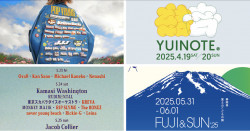
July 31, 2008
Welcome To Japitzerland
Europe’s crossroads of cultures makes room for one more
By Metropolis
Originally published on metropolis.co.jp on July 2008

Photos by John Douglas (JohnDouglasArt.com)
Having been in the news for decades thanks to international summits, secret bank accounts, and famous residents, Switzerland is a land of stereotypes. Like so many of the celebrities who call the country home, the real Switzerland is an enigma familiar to everyone but known by few.
If I told you Switzerland is exciting, would you believe me? Though the country is often cast as a boring destination, nothing could be further from the truth—the Swiss love a good time as much as the rest of us. Its small geographic area belies an enormous diversity of attractions and activities. Outstanding art collections, popular festivals, and extreme sports abound in Europe’s oldest nation, founded in 1291.
Even more surprising are the unexpected but frequent encounters with all things Japanese across the country—and I’m not talking about groups of senior-citizen tourists wearing floppy sunhats. From the impressive collection of noh masks in Zürich’s Museum Rietberg to the traditional Japanese garden in lovely Interlaken, where paragliders float over the town with the majestic Mount Jungfrau as a backdrop, Japanese culture is well appreciated by locals and visitors alike.
Bern, the capital, is one of the country’s most charming cities, yet most people dash through on their way from Zürich to Geneva. The medieval town center is a UNESCO World Heritage site surrounded by green forests. With the impressive Zentrum Paul Klee museum offering insight into the life and work of Japan’s favorite Swiss artist—the place was packed with members of the Paul Klee Society of Japan for its opening in 2005—Bern already has a leg up in attracting visitors. (Lift that leg a little higher and climb into a twike; not quite car, not quite bike, this hybrid vehicle is yet another example of Switzerland’s long history of unconventional design and innovation.)
Lausanne, on Lake Geneva, is home not only to the International Olympic Committee and its fascinating Musée Olympique—note the sumo wrestler statue in the sculpture garden—but also the Béjart Ballet Lausanne, which recently performed Images of Asia at the same time as the city’s famous Collection de l’Art Brut’s hosting of a (temporary) display of Japanese Outsider Art.
In addition to the Olympic Museum, Lausanne is also home to l’École Hotelière, the world’s most prestigious training school for the hotel industry. Graduates need not go far; Switzerland abounds with some of the world’s finest hotels. Beau-Rivage Palace, located right next to the Olympic Museum and the avant-garde Musée de l’Élysée photography museum, is one of the most impressive—a palace in every sense. Its very hip Japanese restaurant offers an unexpected counterpoint to the ornate belle époque interiors.
Palace Luzern is another of Switzerland’s leading hotels, one whose postcard-perfect lakeside setting has been attracting visitors for more than 100 years. Excursions to nearby Mount Pilatus will put you on top of the world, though guests will already experience that sensation thanks to the hotel’s fine service and outstanding surroundings.
Palace Luzern is one of the properties in the Victoria-Jungfrau Collection, as is the splendid flagship Victoria-Jungfrau Grand Hotel & Spa in Interlaken, which is the extreme sports capital of Switzerland. Interlaken is the jumping-off point—literally—for those paragliding enthusiasts, as well as a figurative jumping-off point for Jungfraujoch, one of the highest peaks in Europe. Be surprised by the traditional Japanese garden found on Interlaken’s main street, near the train station.
Geneva, home to the fantastic Bodmer Foundation and its collection of priceless books, including a superb 17th-century manuscript of the poetry collection Ise Monogatari (The Tales of Ise), is also the location of the wonderful Grand Hotel Kempinski, where The Grill restaurant offers diners their very own knife menu. I chose the Shogun, though other blades are on view at Geneva’s wonderful Baur Collections of Far Eastern Arts.
The most Japanese experience of all is found in the city of Zug, the country’s richest. The City Hotel Ochsen offers a divinely charming and totally unexpected luxury of a tatami room penthouse, with beautiful views of Zug’s lake and medieval town center (below). Less than an hour by train from Zürich Airport, Zug sits right on the main rail line between northern and southern Switzerland. The bakeries and design studios alone are worth your time.
Swiss International Air Lines (www.swiss.com) flies nonstop daily from Tokyo to Zürich. Flughafen Zürich is one of the most civilized airports in the world, and it’s situated only a ten-minute train ride from the city center. A Swiss Pass (www.swisstravelsystem.com) makes life easy. Rail, urban transport and (almost all) museum entrance fees across the entire country are covered with one piece of paper. Prices start at around 375 francs per week. In addition to the hotels mentioned here, more affordable accommodation options will still be immaculately clean; check the Lonely Planet website (www.lonelyplanet.com) for a host of budget options across the country. To plan rail trips, check the online timetables at www.sbb.ch/en. The tourism bureau also runs a very helpful website (www.myswitzerland.com/en.cfm)
[geo_mashup_map]







